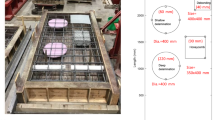Abstract
Full-field noncontact structural geometry morphology monitoring can be used to achieve a breakthrough in the fields of structural safety monitoring and digital twins owing to its advantages of economy, credibility, high frequency, and holography. Moreover, such type of monitoring can improve the precision and efficiency of the structural health monitoring technology and theory of large-scale structures. This study validated the performance of a proposed holographic visual sensor and algorithms in computer vision-based, full-field, noncontact displacement and vibration measurement. On the basis of the temporal and spatial characteristics of the measured series data, denoising, and the disturbance-rejection algorithm, the microscopy algorithm of subpixel motion and the extracting algorithm of motion information were respectively constructed for weak high-order displacement components and the holographic measurement of high-quality geometric morphology. Moreover, an intelligent perception method optimized for holographic-geometric and operational-modal shapes were used to extract morphological features from a series of holographic transient responses under excitation. Experimental results showed that the holographic visual sensor and the proposed algorithms can extract an accurate holographic displacement signal and factually and sensitively accomplish vibration measurement while accurately reflecting the actual change in structural properties under various damage/action conditions. The accuracy and efficiency of the system in the structural geometry monitoring for dense full-field displacement measurement and smooth operational modal shape photogrammetry were confirmed in the experiments. The proposed method could serve as a foundation for further research on digital twins for large-scale structures, structural condition assessment, and intelligent damage identification methods.
Access this chapter
Tax calculation will be finalised at checkout
Purchases are for personal use only
Similar content being viewed by others
References
Feng, D.M., Feng, M.Q.: Computer vision for SHM of civil infrastructure: from dynamic response measurement to damage detection-a review. Eng. Struct. 156, 105–117 (2018)
Editorial Department of China Journal of Highway and Transport: Review on China’s bridge engineering research: 2014. China J. Highw. Transp. 27(5), 1–96 (2014)
Shao, S., Zhou, Z.X., Deng, G.J., Wang, S.R.: Experiment of structural morphology monitoring for bridges based on non-contact remote intelligent perception method. China J. Highw. Transp. 32(11), 91–102 (2019)
Sun, L.M., Shang, Z.Q., Xia, Y.: Development and prospect of bridge structural health monitoring in the context of big data. China J. Highw. Transp. 32(11), 1–20 (2019)
Ye, X.W., Dong, C.Z.: Review of computer vision-based structural displacement monitoring. China J. Highw. Transp. 32(11), 20–39 (2019)
Bao, Y.Q., Li, H., Ou, J.P.: Emerging data technology in structural health monitoring: compressive sensing technology. J. Civ. Struct. Health Monit. 4(2), 77–90 (2012)
Bao, Y.Q., Yu, Y., Li, H., Mao, X.Q., Jiao, W.F., Zou, Z.L., Ou, J.P.: Compressive sensing based lost data recovery of fast-moving wireless sensing for structural health monitoring. Struct. Control Health Monit. 22(3), 433–448 (2015)
Javh, J., Slavič, J., Boltežar, M.: The subpixel resolution of optical-flow-based modal analysis. Mech. Syst. Signal Process. 88, 89–99 (2017)
Guo, J., Zhu, C.A.: Dynamic displacement measurement of large-scale structures based on the Lucas-Kanade template tracking algorithm. Mech. Syst. Signal Process. 66, 425–436 (2016)
Yang, Y.C., Dorn, C., Mancini, T., Talken, Z., Kenyon, G., Farrar, C., Mascareñas, D.: Blind identification of full-field vibration modes from video measurements with phase-based video motion magnification. Mech. Syst. Signal Process. 85, 567–590 (2017)
Xu, Y., Brownjohn, J., Kong, D.L.: A non-contact vision-based system for multipoint displacement monitoring in a cable-stayed footbridge. Struct. Control Health Monit. 25(5), 21–55 (2018)
Cha, Y.J., Chen, J.G., Büyüköztürk, O.: Output-only computer vision based damage detection using phase-based optical flow and unscented Kalman filters. Eng. Struct. 132, 300–313 (2017)
Feng, D.M., Feng, M.Q.: Model updating of railway bridge using in situ dynamic displacement measurement under trainloads. J. Bridge Eng. 20, 04015019 (2015)
Cha, Y.J., Trocha, P., Büyüköztürk, O.: Field measurement-based system identification and dynamic response prediction of a unique MIT building. Sensors 16, 1016 (2016)
Mei, Q.P., Gül, M., Boay, M.: Indirect health monitoring of bridges using Mel-frequency cepstral coefficients and principal component analysis. Mech. Syst. Signal Process. 119, 523–546 (2019)
Shao, S., Zhou, Z.X., Deng, G.J., Du, P., Jian, C.Y., Yu, Z.Y.: Experiment of structural geometric morphology monitoring for bridges using holographic visual sensor. Sensors 20, 1187 (2020)
Author information
Authors and Affiliations
Corresponding author
Editor information
Editors and Affiliations
Rights and permissions
Copyright information
© 2021 The Author(s), under exclusive license to Springer Nature Switzerland AG
About this paper
Cite this paper
Shao, S., Deng, G., Zhou, Z. (2021). Structural Geometric Morphology Monitoring for Bridges Using Holographic Visual Sensor. In: Rizzo, P., Milazzo, A. (eds) European Workshop on Structural Health Monitoring. EWSHM 2020. Lecture Notes in Civil Engineering, vol 128. Springer, Cham. https://doi.org/10.1007/978-3-030-64908-1_1
Download citation
DOI: https://doi.org/10.1007/978-3-030-64908-1_1
Published:
Publisher Name: Springer, Cham
Print ISBN: 978-3-030-64907-4
Online ISBN: 978-3-030-64908-1
eBook Packages: EngineeringEngineering (R0)




